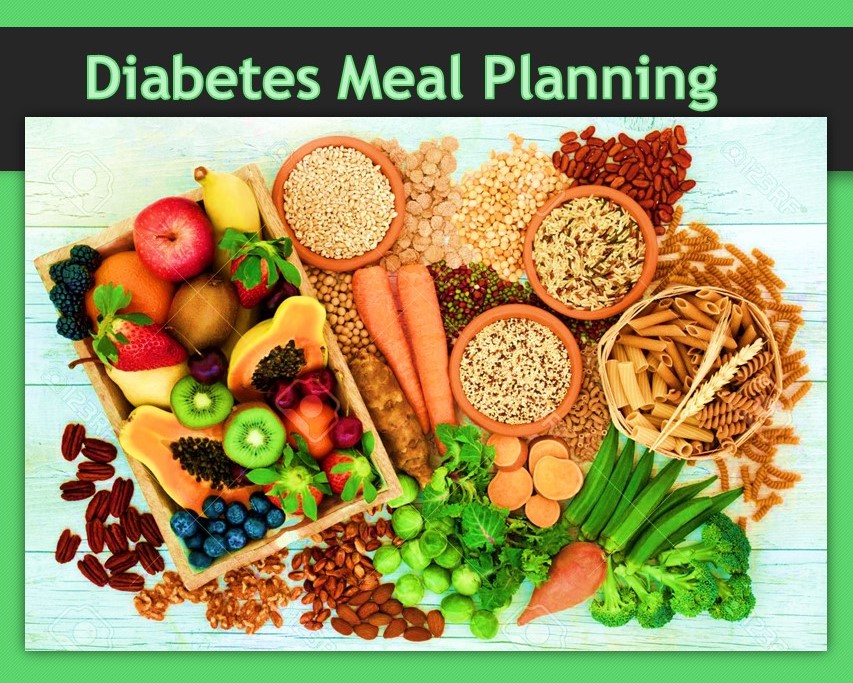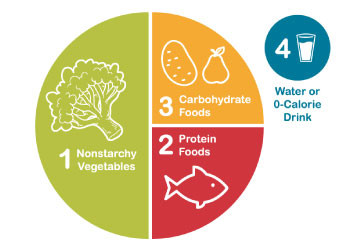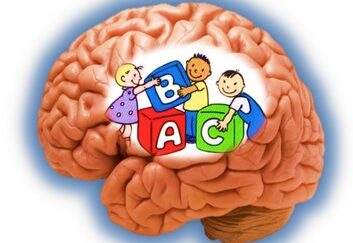
This article has the simple guidelines which will help you to create your diabetic meal plan. To read about the diabetes mellitus in detail, click here: Diabetes: Manage Well, Live Well!
“What can I eat?” is one of the top questions asked by people with diabetes when they are diagnosed. Everyone’s body responds differently to different types of foods and diets, so there is no single “magic” diet for diabetes. But you can follow a few simple guidelines to find out what works for you to help manage your blood sugar. When it comes to managing diabetes, the carbohydrates, or carbs, you eat play an important role. They impact your blood sugar, so remember that balance is key!
I have written the basic information about food below. Based on your blood sugar levels, your activity level, your diabetic medications and lifestyle, you can be creative with your diabetic meal plan. A registered dietitian can help make an eating plan just for you.
A meal plan is your guide for when, what, and how much to eat to get the nutrition you need while keeping your blood sugar levels in your target range. It is simply a low-glycemic diet.
Healthy diabetic eating includes
- Limiting foods that are high in sugar
- Eating smaller portions, spread out over the day
- Being careful about when and how many carbohydrates you eat
- Eating a variety of whole-grain foods, fruits and vegetables every day
- Eating less fat
- Limiting your use of alcohol
- Using less salt
The key to eating with diabetes is to eat a variety of healthy foods from all food groups, in the amounts your meal plan outlines.
The food groups are
- Vegetables
- non starchy: includes asparagus, artichoke, avocado, broccoli, cabbage, cauliflower, celery, cucumber, eggplant, greens, lettuce, mushrooms, peppers, tomatoes, okra, onions, spinach, summer squash, zucchini, turnips
- starchy: includes potatoes, corn, and green peas
- Fruits—includes oranges, melon, berries, apples, bananas, and grapes
- Grains—at least half of your grains for the day should be whole grains
- includes wheat, rice, oats, cornmeal, barley, and quinoa
- examples: bread, pasta, cereal, and tortillas
- Protein
- lean meat
- chicken or turkey without the skin
- fish
- eggs
- nuts and peanuts
- dried beans and certain peas, such as chickpeas and split peas
- meat substitutes, such as tofu
- Dairy—nonfat or low fat
- milk or lactose-free milk if you have lactose intolerance
- yogurt
- cheese
There are many different tools that can help you plan meals. They are:
- Counting carbs
- Glycemic index
- The plate method
- Portion size
A. Counting carbs:
There are three main types of carbohydrates (carbs) in food—starches, sugar and fiber. As you’ll see on the nutrition labels for the food you buy, the term “total carbohydrate” refers to all three of these types.
- Sugars, such as the natural sugar in fruit and milk or the added sugar in soda and many other packaged foods.
- Starches, including wheat, oats, and other grains; starchy vegetables such as corn and potatoes; and dried beans, lentils, and peas.
- Fiber, the part of plant foods that isn’t digested but helps you stay healthy.
Sugars and starches raise your blood sugar, but fiber doesn’t.
Carbohydrate counting involves keeping track of the amount of carbohydrates you eat and drink each day. Because carbohydrates turn into glucose in your body, they affect your blood glucose level more than other foods do. Carb counting can help you manage your blood glucose level. If you take insulin, counting carbohydrates can help you know how much insulin to take. Carbohydrate counting is a meal planning tool for people with diabetes who take insulin, but not all people with diabetes need to count carbohydrates. Most carbohydrates come from starches, fruits, milk, and sweets. Try to limit carbohydrates with added sugars or those with refined grains, such as white bread and white rice. Instead, eat carbohydrates from fruit, vegetables, whole grains, beans, and low-fat or nonfat milk.
B. Glycemic index:
You need to be familiar with the term, glycemic index. Glycemic index (GI) is a measure of how quickly a food can make your blood sugar (glucose) rise. Only foods that contain carbohydrates have a GI. Foods such as oils, fats, and meats do not have a GI. In general, low GI foods increase glucose slowly in your body. Foods with a high GI increase blood glucose quickly. Foods with high GI make it harder to control diabetes. On the contrary, eating low GI foods can help you gain tighter control over your blood sugar. The GI scale goes from 0 to 100. Pure glucose has the highest GI and is given a value of 100.
Glycemic Index of Certain Foods
Low GI foods (0 to 55):
- Dalia/cracked wheat, barley, bajra (pearl millet), buckwheat, oats, poha, quinoa, Ragi/nachni (finger millet), Parboiled (converted) rice, Foxtail millet (Korra biyyam or kangni or rala), Barnyard millet (Bhagar, Sanwa)
- High-fiber bran cereal
- Carrots, non-starchy vegetables (asparagus, artichoke, avocado,
broccoli, cabbage, cauliflower, celery, cucumber, eggplant, lettuce, mushrooms, peppers, tomatoes, okra, onions, spinach, summer squash, zucchini, turnips), and greens - Apples, oranges, banana, grapefruit, mangoes and many other fruits
- Nuts: almonds, peanuts, pecans, sunflower seeds, hazelnuts, walnuts
- legumes, and beans: black eyed peas, butter beans, chick peas, green beans, kidney beans, pinto beans, lentils (moong, matki, chana, chawli, rajma, toor dal), lima beans, navy beans, snow peas, hummus
- Milk and yogurt
Moderate GI foods (56 to 69):
- Pita bread, rye bread, Jowar (Sorghum)
- Couscous (made from durum wheat or semolina flour)
- Brown rice
- Raisins
- Indian dosa
High GI foods (70 and higher):
- White bread and bagels
- Most processed cereals and instant oatmeal, including bran flakes
- Most snack foods
- Potatoes
- White rice
- Honey
- Watermelon, pineapple
C. The plate method: For more information, click here: A Mindful Diet
It is easy to eat more food than you need without realizing it. The plate method helps you control your portion sizes. You don’t need to count calories. The plate method shows the amount of each food group you should eat. This method works best for lunch and dinner.
Start with a 9-inch dinner plate:
- Fill half with non-starchy vegetables, such as salad, green beans, broccoli, cauliflower, cabbage, and carrots.
- Fill one quarter with a lean protein, such as chicken, turkey, beans, tofu, or eggs.
- Fill a quarter with a grain or starchy food, such as potatoes, corn, rice, or pasta (or skip the starch altogether and double up on non-starchy veggies). You also may eat a small bowl of fruit or a piece of fruit, and drink a small glass of milk as included in your meal plan.

D. Portion size:
A portion is the amount of food you choose to eat at one time. Overeating can make both your blood sugar and your weight harder to manage. Proper nutrition and portion control can play an important role in the diabetic meal planning.
- You can use everyday objects or your hand to judge the size of a portion.
- 1 serving of meat or poultry is the palm of your hand or a deck of cards
- 1 3-ounce serving of fish is a checkbook
- 1 serving of cheese is six dice
- 1/2 cup of cooked rice or pasta is a rounded handful or a tennis ball
- 1 serving of a pancake or waffle is a DVD
- 2 tablespoons of peanut butter is a ping-pong ball
When planning your meals:
- Choose foods that have a low to medium GI.
- When eating a high GI food, combine it with low GI foods to balance the effect on your glucose levels. The GI of a food changes when you combine it with other foods.
- Switch from White Rice to Brown Rice: Brown rice possesses a medium glycemic index and is a lot more nutritious compared to white rice. It is also rich in fiber and this will keep your stomach fuller for longer. This will avoid unnecessary snack cravings and will in the long run help control blood sugar values.
Foods and drinks to limit include
- Fried foods and other foods high in saturated fat and trans fat
- Foods high in salt, also called sodium
- Sweets, such as baked goods, candy, and ice cream
- Beverages with added sugars, such as juice, regular soda, and regular sports or energy drinks
- Drink water instead of sweetened beverages.
- Consider using a sugar substitute in your coffee or tea. There are six types of artificial sweeteners currently approved by the FDA.

I found this 7-day Indian diet chart for diabetes, by Dr Parul Patni, Nutritionist.5







References:
- https://www.niddk.nih.gov/health-information/diabetes/overview/what-is-diabetes
- https://www.diabetes.org/diabetes
- https://www.cdc.gov/diabetes/managing/eat-well/meal-plan-method.html
- https://medlineplus.gov/ency/patientinstructions/000941.htm
- 7-day-indian-diet-plan-for-type-2-diabetes

I’ve been a diabetic for many years. I’ve always felt that words used to guide people like me, were somewhat harsh. This caused a feeling of failure and unattainable goals. What you prepared for us, makes meal planning simple and achievable. I always look forward to reading your articles because they are always informative and helpful. Thank you once again you Dr. Bandari. By the way, the Indian foods as a trial for 7 days would be good for me. I just need to get some additional items to make the meals.
Thank you, dear Daunne. I look forward to hear about your trials with Indian food 🙂
Really very good and useful information for diabetes…Mainly Indian diet mentioned is very familiar and easy to follow..I read many of ur articles which are very informative to everybody..Thank you very much once again Dr.Savitri (Sister) for sharing such a good information.
Yes, Sowmya, I tried to focus on Indian as well as western diet, so that it can be beneficial for more people. Thank you.
Dr. Savitra .. Very informative interesting and educative article..
Good Efforts you are taking .. I feel proud that I m your Classmate …
My wife is Diabetic with good Glycemic controll… But she is very Adhyatmic and having Fast 3 days in a week ..Eating Shabudana ..Bhagar like that ..
How can it be planned her Diet ..
Thank you very much, Durgadas. I am not a Diabetes expertise. I wrote these articles due to people’s requests. But I can tell you that, let her eat Bhagar (Barnyard millet) which has low glycemic index. It is gluten free and very good source of protein. It is very beneficial for diabetics. She can cut down on sabudana and consume bhagar and fruits on her fast days. Hope, it helps. Thanks again.